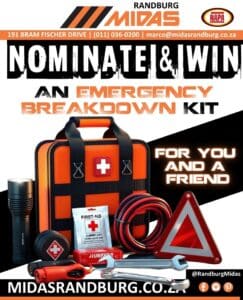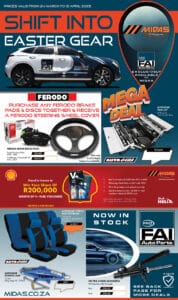If you are new to motor cycle riding or if you are considering getting a motorbike this article will come in very handy. Here are our top 10 Motorcycle safety tips for new riders #MotorBikes
Regardless of what bike you have or how you ride it, without the correct highest grade engine oil it will be uphill battle from word go. The best habit you can get into is to use high quality engine oil like Motul engine oil which is available from Randburg Midas.
Don’t buy more bike than you can handle. If you’ve been off of motorcycles for a while, you may be surprised by the performance of today’s bikes. Even models with small-displacement engines are notably faster and more powerful than they were 10 or 20 years ago.
When shopping for a bike, start with one that fits you. When seated, you should easily be able to rest both feet flat on the ground without having to be on tiptoes. Handlebars and controls should be within easy reach. Choose a model that’s easy for you to get on and off the center stand; if it feels too heavy, it probably is. A smaller model with a 250- to 300-cc engine can make a great starter or commuter bike. If you plan on doing a lot of highway riding, you might want one with an engine in the 500- to 750-cc range so you can easily keep up with traffic.
Invest in antilock brakes. Now available on a wide array of models, antilock brakes are a proven lifesaver. IIHS data shows that motorcycles equipped with ABS brakes were 37 percent less likely to be involved in a crash than bikes without it. No matter what kind of rider you are, ABS can brake better than you.
The reason is simple: Locking up the brakes in a panic stop robs the rider of any steering control. That can easily lead to a skid and crash, which can result in serious injury. ABS helps you retain steering control during an emergency stop, and it can be especially valuable in slippery conditions.
This critical feature is now standard on many high-end models and adds only a few thousand rands to the price of more basic bikes. You may be able to offset some of the cost with an insurance discount. Either way, we think it’s a worthwhile investment in your safety.
Hone your skills. There is nothing we could say or advise more than to go find a Motorcycle Safety riding course in your area. That’s critical, absolutely critical. A safety course or similar class can teach you the basics, as well as advanced techniques, such as how to perform evasive emergency maneuvers.
Use your head. Yes, helmets are an emotional topic for some riders. But the facts show the risk. Riders without a helmet are 40 percent more likely to suffer a fatal head injury in a crash and are three times more likely to suffer brain injuries, than those with helmets.
Modern helmets are strong, light weight, and comfortable, and they cut down on wind noise and fatigue. Keep in mind that helmets deteriorate over time, and may not be safe even if they look fine. We recommend replacing a helmet every five years, or sooner if it’s been damaged or has been in a crash. Beyond potential deterioration due to aging and exposure to hair oils and chemicals.
Wear the right gear. Jeans, a T-shirt, and sandals are recipes for a painful disaster on a bike. Instead, you want gear that will protect you from wind chill, flying bugs and debris, and, yes, lots of road rash if you should slide out. For maximum protection, go for a leather or other reinforced jacket, gloves, full pants, and over-the-ankle footwear, even in summer. Specially designed jackets with rugged padding and breathable mesh material provide protection as well as ventilation for riding in warm weather. You’ll also want effective eye protection; don’t rely on eyeglasses or a bike’s windscreen. Use a helmet visor or goggles. And keep in mind that car drivers who have hit a motorcycle rider often say they just didn’t see them, so choose gear in bright colors.
Be defensive. You need to be extra alert, especially in this age of epidemic phone use and texting behind the wheel. Keep an eye out for cars suddenly changing lanes or pulling out from side streets. And don’t tailgate; keeping a safe following distance is critical, both to ensure you have enough stopping distance and so you have time to react to obstacles in the road. An object that a car might easily straddle could be a serious hazard when on a bike.
Avoid bad weather. Slippery conditions reduce your margin for error. Rain not only cuts your visibility but reduces your tires’ grip on the road, which can make cornering tricky. If you need to ride in the rain, remember that the most dangerous time is right after precipitation begins, as the water can cause oil residue to rise to the top. And avoid making sudden maneuvers. Be especially gentle with the brakes, throttle, and steering to avoid sliding. When riding in strong side winds, be proactive in anticipating the potential push from the side by moving to the side of the lane the wind is coming from. This will give you some leeway in the lane, should a gust nudge you.
Watch for road hazards. A motorcycle has less contact with the pavement than a car. Sand, wet leaves, or pebbles can cause a bike to slide unexpectedly, easily resulting in a spill. Bumps and potholes that you might barely notice in a car can pose serious danger when on a bike. If you can’t avoid them, slow down as much as possible before encountering them, with minimal steering input. Railroad tracks and other hazards should be approached as close to a right angle as possible, to reduce the chances of a skid.
Be ready to roll. Before each ride, do a quick walk-around to make sure your lights, horn, and directional signals are working properly. Check the chain, belt, or shaft and the brakes. And inspect the tires for wear and make sure they’re set at the proper pressure. Motorcycle mechanics we’ve spoken with say they routinely see worn-out brakes and improperly inflated tires that greatly increase safety risks. When tires are under-inflated, handling gets really hard, steering gets hard, and the bike doesn’t want to lean.
For more information on our range of motorcycle products and more, please contact us www.midasrandburg.co.za | (011) 789-4411 | marco@midasrandburg.co.za | 191 Bram Fischer Drive, Randburg.
Connect with us and share your photos of your goodies from Randburg Midas and tag #RandburgMidas
Facebook | Twitter | Youtube | Google+ | Instagram | LinkedIn | Pinterest
Source: http://www.consumerreports.org/cro/2013/04/10-motorcycle-safety-tips-for-new-riders/index.htm





